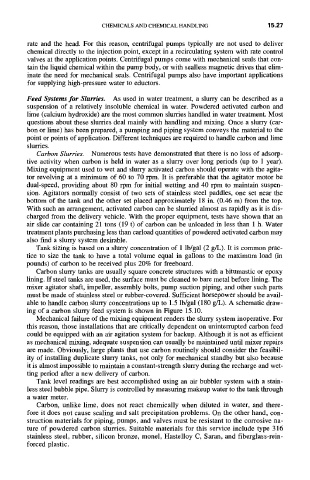Page 521 -
P. 521
CHEMICALS AND CHEMICAL HANDLING 15.27
rate and the head. For this reason, centrifugal pumps typically are not used to deliver
chemical directly to the injection point, except in a recirculating system with rate control
valves at the application points. Centrifugal pumps come with mechanical seals that con-
tain the liquid chemical within the pump body, or with sealless magnetic drives that elim-
inate the need for mechanical seals. Centrifugal pumps also have important applications
for supplying high-pressure water to eductors.
Feed Systems for Slurries. As used in water treatment, a slurry can be described as a
suspension of a relatively insoluble chemical in water. Powdered activated carbon and
lime (calcium hydroxide) are the most common slurries handled in water treatment. Most
questions about these slurries deal mainly with handling and mixing. Once a slurry (car-
bon or lime) has been prepared, a pumping and piping system conveys the material to the
point or points of application. Different techniques are required to handle carbon and lime
slurries.
Carbon Slurries. Numerous tests have demonstrated that there is no loss of adsorp-
tive activity when carbon is held in water as a slurry over long periods (up to 1 year).
Mixing equipment used to wet and slurry activated carbon should operate with the agita-
tor revolving at a minimum of 60 to 70 rpm. It is preferable that the agitator motor be
dual-speed, providing about 80 rpm for initial wetting and 40 rpm to maintain suspen-
sion. Agitators normally consist of two sets of stainless steel paddles, one set near the
bottom of the tank and the other set placed approximately 18 in. (0.46 m) from the top.
With such an arrangement, activated carbon can be slurried almost as rapidly as it is dis-
charged from the delivery vehicle. With the proper equipment, tests have shown that an
air slide car containing 21 tons (19 t) of carbon can be unloaded in less than 1 h. Water
treatment plants purchasing less than carload quantities of powdered activated carbon may
also find a slurry system desirable.
Tank sizing is based on a slurry concentration of 1 lb/gal (2 g/L). It is common prac-
tice to size the tank to have a total volume equal in gallons to the maximum load (in
pounds) of carbon to be received plus 20% for freeboard.
Carbon slurry tanks are usually square concrete structures with a bitumastic or epoxy
lining. If steel tanks are used, the surface must be cleaned to bare metal before lining. The
mixer agitator shaft, impeller, assembly bolts, pump suction piping, and other such parts
must be made of stainless steel or rubber-covered. Sufficient horsepower should be avail-
able to handle carbon slurry concentrations up to 1.5 lb/gal (180 g/L). A schematic draw-
ing of a carbon slurry feed system is shown in Figure 15.10.
Mechanical failure of the mixing equipment renders the slurry system inoperative. For
this reason, those installations that are critically dependent on uninterrupted carbon feed
could be equipped with an air agitation system for backup. Although it is not as efficient
as mechanical mixing, adequate suspension can usually be maintained until mixer repairs
are made. Obviously, large plants that use carbon routinely should consider the feasibil-
ity of installing duplicate slurry tanks, not only for mechanical standby but also because
it is almost impossible to maintain a constant-strength slurry during the recharge and wet-
ting period after a new delivery of carbon.
Tank level readings are best accomplished using an air bubbler system with a stain-
less steel bubble pipe. Slurry is controlled by measuring makeup water to the tank through
a water meter.
Carbon, unlike lime, does not react chemically when diluted in water, and there-
fore it does not cause scaling and salt precipitation problems. On the other hand, con-
struction materials for piping, pumps, and valves must be resistant to the corrosive na-
ture of powdered carbon slurries. Suitable materials for this service include type 316
stainless steel, rubber, silicon bronze, monel, Hastelloy C, Saran, and fiberglass-rein-
forced plastic.

